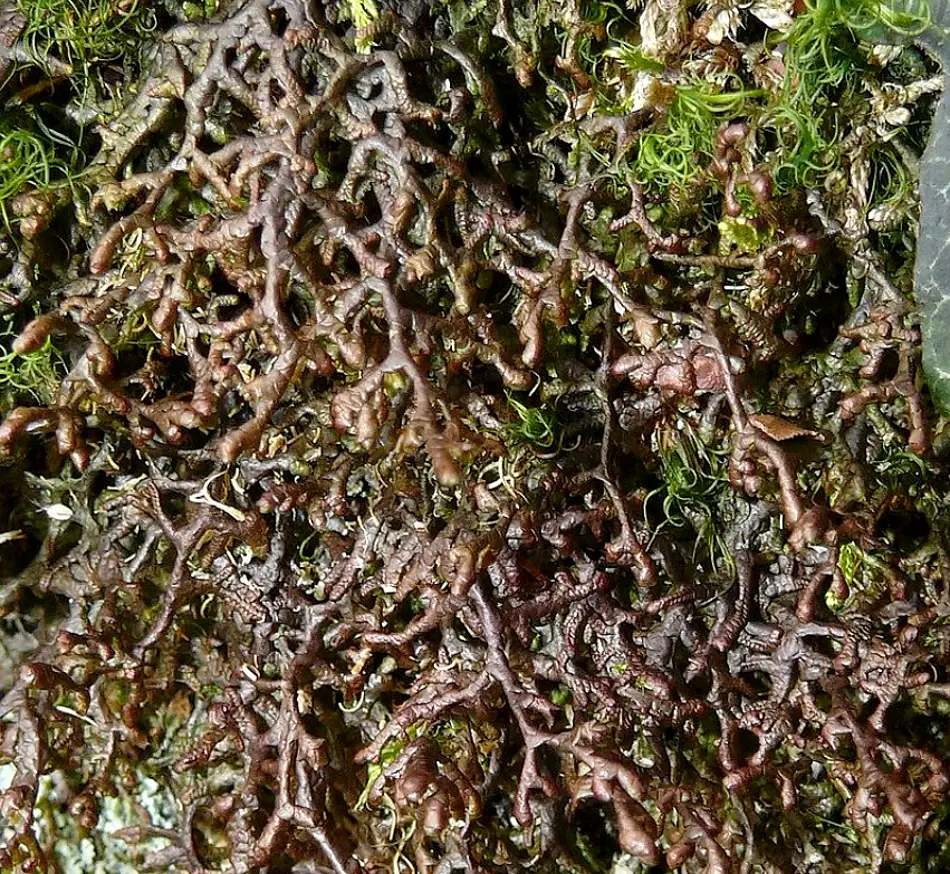Contents
CLASSIFICATION OF FRULLANIA
Kingdom :- Plantae
Division :- Bryophyta
Class :- Hepaticopsida
Order :- Jungermanniales
Family :- Frullaniaceae
Genus :- Frullania
EXTERNAL MORPHOLOGY OF FRULLANIA
- The plants are large or medium sized but rarely small. These are reddish-brown or nearly black in colour.
- The plant body is a gametophyte. It is differentiated into a branched, prostrate, central, stem-like axis and the leaves.
- The thallus is attached to the substratum by unicellular, smooth walled rhizoids which arise in tufts from the bases or middle of the amphigastria.
- The prostrate stem is pinnately or bipinnately branched.
- The leaves on the stem are arranged in three rows-two rows of lateral leaves and a row of underleaves or amphigastria. Each lateral leaf is bipartite forming a large expanded antical lobe and a small postical lobe.
- The antical lobe is obliquely ovate or suborbicular and almost always entire.
- The postical lobe, also called lobule is cucullate, galeate or saccate. It may either form a water sac or may remain open. 8. The postical lobe usually bears a short subulate process, the stylus near its attachment between the postical lobe and the stem.
- Unde rleaves or amphigastria are usually smaller. These are rounded, notched or deeply lobed.
ANATOMY OF THE STEM OF FRULLANIA
- s. of the stem is almost circular in outline.
- Well defined epidermis is absent.
- The section shows cortical and medullary regions.
- The cortex is 2 to 3 cells deep. It consists of small cells with distinct thickened pigmented walls.
- The central part is called medullary region. It is made of large and elongated cells with thin colour less walls.
ANTHERIDIAL BRANCH AND ANTHERIDA OF FRULLANIA
- The species of this genus are dioecious as well as monoecious.
- Monoecious species are autoicous i.e. antheridia and archegonia are borne by different branches.
- The antheridia occur in the axils of bracts (perigonial bracts) borne on short laterals.
- The perigonial bracts are densely imbricate and are divided into two almost equal lobes, large in size.
- There are usually two antheridia in the axil of each bract.
- A mature antheridium consists of a stalk and a body.
- The stalk is slender and multicellular being composed of two rows of cells.
- The body of the antheridium is globose. It consists of a central mass of androcyte mother cells and one-celled wall or jacket.
- Androcyte mother cell divides, each forming two biflagellate antherozoids.
ARCHEGONIAL BRANCH AND THE ARCHEGONIUM OF FRULLANIA
- The archegonia occur in groups at the apices of short lateral branches. Each group has two to four archegonia.
- A group of archegonia is surrounded by 2 to 5 pairs of perichaetial bracts which are dentate or lobed and larger than foliage leaves.
- The inner pairs of bracts are connate with each other.
- The uppermost bracts are laterally fused to form perianth.
- The perianth is inversely heart shaped and much contracted to form a small, tubular mouth.
- A mature archegonium is a flask shaped structure consisting of a basal ventre and the upper neck.
- The venter has two layered wall that surrounds a small egg cell and a venter canal cell situated just above it.
- The neck consists of five vertical rows of neck cells which surround an axial row of eight neck canal cells.
SPOROPHYTE OF FRULLANIA
- A mature sporophyte consists of foot, seta and capsule.
- The foot remains embedded in the tissue of the female branch.
- The seta is very short and only 8-9 cells thick. It is not very distinct from the capsule because of the mass of thin walled tissue at the base of the capsule (resembling apophysis of moss sporogonium).
- The capsule wall is made of two layers of cells.
- The cells of the outer layer have thick rod-like fibres on their lateral walls especially at the comers.
- The cells of the inner layers have walls with irregular network of thickening fibres.
- Inside the wall there are about 80 elaters and large number of spores.
- The elaters run from the roof to the floor of the capsule. These alternate with vertical rows of spores. Each elater is flattened. It has a single broad spiral band of thickening. The lower end of the elater is trumpet shaped.
- The spores are large, oblong to roundish. The wall is two layered, the exospore and the endospore. The exospore is rough, tuberculate and verrucose. The cytoplasm has a nucleus and a chloroplast.
IDENTIFICATION
- DIVISION – Bryophyta
- True roots absent and instead are present the rhizoids.
- No true vascular strands.
- Class:- Hepaticopsida
- Rhizoids without septa
- Chloroplasts without pyrenoids
- Columella absent from capsule and there are stomata on capsule wall.
- Order– Jungermanniales
- Scales absent.
- Rhizoids smooth walled.
- Antheridia and archegonia are borne at the apices
- Archegonial neck consists of 5 vertical rows of cells.
- Gametophyte with stem and two rows of dorsal, and a third ventral row of leaves.
- Archegonia in a terminal cluster and the last archegonium is formed by the apical cell.
- Family – Frullaniaceae
- Stems usually pinnately branched.
- Rhizoids form a tuft at the base or middle of the under leaf.
- Lateral leaves complicate-bilobed.
- Perianth compressed and obtrusely triangular in cross section
- Genus – Frullania
- Branch develops from the ventral half of a lateral segment replacing lobule of the leaf.
- Presence of stylus.


Leave a Reply